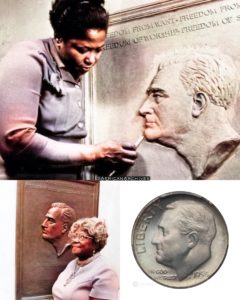Selma Burke was born in Mooresville, NC in 1900. Her father was both a minister and a railroad brakeman. Her mother wanted her 10 children to be professionally trained, and that led Selma to getting a nursing degree. Her mother actually began her college career when she was 75.
While Selma had a professional education, it was artistic influences that led to her purpose in life. As a young child, she would use riverbed clay when washing clothes. She loved the feel of the clay in her hands and would sculpt objects. As she later said: “It was there in 1907 that I discovered me.”
Both her father and uncles worked abroad and collected works of art. When they died, the artifacts became a further nudge for Selma’s artistic career. But first came the necessity of earning a living. She moved to Philadelphia to work as a private nurse for the heiress to the Otis Elevator fortune. She was encouraged to continue her artistic interests by the heiress. Selma became immersed in the cultural life of Philadelphia.
When the heiress died, Selma moved to Harlem, NY and became involved with the Harlem Renaissance, where she took art classes. When there was an announcement of a national competition to create a profile portrait of President Franklin Roosevelt, she entered and won the contract.
The President agreed to do a sitting and Selma completed a bronze plaque with the President’s face and his four freedoms shown above (see below). When the decision was made to incorporate President Roosevelt’s image on the U.S. dime, the image that was used bore a striking resemblance to Selma’s portrait (see below). Unfortunately, the chief engraver of the U.S. mint put his initials on the coin. It has only been recently that Selma has been credited with the original image.
While Selma never had any children of her own, she was a strong advocate for children to experience the joys of art as she had. She funded arts schools in both NYC and Pittsburgh. She also became involved in teaching at a number of colleges and arts programs.
Selma passed away at the age of 94 from cancer. Toward the end of her life, she received a number of awards. But like many hidden heroes, her signature accomplishment (the Roosevelt dime) was not credited to her in her lifetime. Unfortunately, the impact of segregation was also felt in the lack of credit given to African-Americans for their many achievements.
* * *
“I really live and move in the atmosphere in which I am creating.”– Selma Burke upon receiving the Art Lifetime Achievement Award
